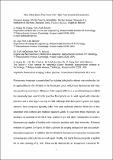M13 Virus‐Based Framework for High Fluorescence Enhancement
Author(s)
Qi, Jifa; deQuilettes, Dane W.; Huang, Mantao; Lin, Ching-Wei; Bardhan, Neelkanth Manoj; Dang, Xiangnan; Bulović, Vladimir; Belcher, Angela M; Huang, Shengnan,Ph.D.Massachusetts Institute of Technology.; ... Show more Show less
DownloadM13 Virus-based Framework for High Fluorescence Enhancement.pdf (1.294Mb)
Open Access Policy
Open Access Policy
Creative Commons Attribution-Noncommercial-Share Alike
Terms of use
Metadata
Show full item recordAbstract
Fluorescence imaging is a powerful tool for studying biologically relevant macromolecules, but its applicability is often limited by the fluorescent probe, which must demonstrate both high site‐specificity and emission efficiency. In this regard, M13 virus, a versatile biological scaffold, has previously been used to both assemble fluorophores on its viral capsid with molecular precision and to also target a variety of cells. Although M13‐fluorophore systems are highly selective, these complexes typically suffer from poor molecular detection limits due to low absorption cross‐sections and moderate quantum yields. To overcome these challenges, a coassembly of the M13 virus, cyanine 3 dye, and silver nanoparticles is developed to create a fluorescent tag capable of binding with molecular precision with high emissivity. Enhanced emission of cyanine 3 of up to 24‐fold is achieved by varying nanoparticle size and particle‐fluorophore separation. In addition, it is found that the fluorescence enhancement increases with increasing dye surface density on the viral capsid. Finally, this highly fluorescent probe is applied for in vitro staining of E. coli . These results demonstrate an inexpensive framework for achieving tuned fluorescence enhancements. The methodology developed in this work is potentially amendable to fluorescent detection of a wide range of M13/cell combinations.
Date issued
2019-05Department
Massachusetts Institute of Technology. Department of Materials Science and Engineering; Massachusetts Institute of Technology. Department of Biological Engineering; Koch Institute for Integrative Cancer Research at MITJournal
Small
Publisher
Wiley
Citation
Huang, Shengnan et al. "M13 Virus‐Based Framework for High Fluorescence Enhancement." Small 15, 28 (May 2019): 1901233 © 2019 WILEY‐VCH Verlag GmbH & Co
Version: Author's final manuscript
ISSN
1613-6810
1613-6829